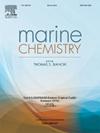MNPs in marine environment: Sources, distribution, trophic transfer, toxicity, fate and the remediating role of epiplastic syntrophic microbial consortia (Biofilms)
IF 2.5
3区 地球科学
Q2 CHEMISTRY, MULTIDISCIPLINARY
引用次数: 0
Abstract
This review focuses on plastic pollution, which has emerged as an urgent environmental issue with microplastics (MiPs) and nanoplastics (NaPs) being widespread contaminants in marine ecosystem. These particles pose serious ecological and public health risks due to their ability to bioaccumulate and vertically transfer through the food chain rapidly. Ingestion of MiPs and NaPs (MNPs) causes harmful physiological and reproductive effects, threatening the stability and integrity of marine food chains. This review summarizes the sources, distribution, trophic transfer, toxicity and fate of MNPs involving the marine ecosystem. Microbial communities have displayed potential as remediating agent for MNPs; though the processes involved in NaP degradation remain poorly understood, highlighting the need for further research. The distinctive properties of NaPs complicate their interactions with microbial communities, pointing to the necessity for focused studies on their biodegradation pathways. This review advocates for a holistic strategy that employs epiplastic syntrophic microbial consortia (Biofilm) as bioremediating agents, as their interactions may enhance breakdown of MNPs in marine setting. Future research should aim to clarify the relationships between microbial consortia and NaPs, identifying ideal conditions that foster microbial growth and activity on these NaPs. This review will be helpful for innovating effective management strategies to reduce the impacts of these established pollutants; ultimately, increasing our understanding of MNPs in marine environment, which is critical for shaping policies that safeguards the future of marine ecosystem and public health. Tackling plastic pollution requires a collaborative approach across all scientific fields, emphasizing the gravity of this global challenge.
海洋环境中MNPs的来源、分布、营养转移、毒性、命运和修复作用
微塑料和纳米塑料是海洋生态系统中广泛存在的污染物,塑料污染已成为一个紧迫的环境问题。由于这些颗粒具有生物积累和通过食物链迅速垂直转移的能力,它们构成严重的生态和公共卫生风险。摄入mip和nap (MNPs)会造成有害的生理和生殖影响,威胁到海洋食物链的稳定性和完整性。本文综述了涉及海洋生态系统的MNPs的来源、分布、营养转移、毒性和命运。微生物群落已显示出作为MNPs修复剂的潜力;尽管对NaP降解过程的了解仍然很少,这表明需要进一步的研究。nap的独特特性使其与微生物群落的相互作用复杂化,这表明有必要对其生物降解途径进行重点研究。这篇综述提倡采用一种整体的策略,采用表观共生微生物联盟(生物膜)作为生物修复剂,因为它们的相互作用可能会增强海洋环境中MNPs的分解。未来的研究应旨在阐明微生物群落与nap之间的关系,确定促进这些nap上微生物生长和活性的理想条件。这将有助于创新有效的管理策略,以减少这些既定污染物的影响;最终,增进我们对海洋环境中的跨国企业的了解,这对于制定保障海洋生态系统和公众健康未来的政策至关重要。解决塑料污染需要所有科学领域的合作,强调这一全球挑战的严重性。
本文章由计算机程序翻译,如有差异,请以英文原文为准。
求助全文
约1分钟内获得全文
求助全文
来源期刊

Marine Chemistry
化学-海洋学
CiteScore
6.00
自引率
3.30%
发文量
70
审稿时长
4.5 months
期刊介绍:
Marine Chemistry is an international medium for the publication of original studies and occasional reviews in the field of chemistry in the marine environment, with emphasis on the dynamic approach. The journal endeavours to cover all aspects, from chemical processes to theoretical and experimental work, and, by providing a central channel of communication, to speed the flow of information in this relatively new and rapidly expanding discipline.
 求助内容:
求助内容: 应助结果提醒方式:
应助结果提醒方式:


